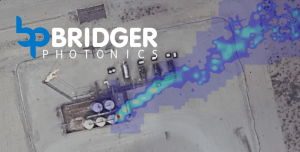This application is a massive breakthrough for the oil and gas industry and for Bridger. We are thrilled to be a part of it. All the hard work and innovation from our amazing team has paid off.”
BOZEMAN, MONTANA, UNITED STATES, April 9, 2021 /EINPresswire.com/ -- Today, Bridger Photonics? Light Detection and Ranging (LiDAR) technology was selected by ExxonMobil for incorporation into the first-ever filing of an application with the U.S. Environmental Protection Agency (EPA) to use cutting-edge technology for methane emissions and other regulatory compliance.— Pete Roos, CEO
EPA Regulations (40 CFR Part 60 Subpart OOOOa) require oil and gas producers to inspect their equipment for leaks of methane volatile organic compounds and other pollutants. The regulation prescribes that field crews must visit hundreds of thousands of U.S. production sites on foot and inspect each piece of equipment by hand in search of leaks. While this leak detection process was considered the best available at the time, it is costly and time consuming, and has increased field crews? exposures to on-site hazards.
Bridger Photonics was selected after an extensive vetting process including field trials of emerging methane detection technologies to identify more efficient, and more effective ways to detect and quantify methane leaks.
Instead of visiting sites on foot, Bridger Photonics scans sites from aircraft using its advanced LiDAR technology, Gas Mapping LiDAR?, to sensitively and quickly detect and estimate methane emissions throughout the entire natural gas value chain (production, transmission, and distribution of natural gas). Bridger hands its clients a map that pinpoints (GPS coordinates), images, and estimates the quantity of every detectable emission in the client?s infrastructure. These data products provide actionable information for field crews to easily find and prioritize leaks.
?What used to take six months for field crews to inspect now takes a matter of days with Gas Mapping LiDAR?,? said Dr. Pete Roos, CEO and co-founder of Bridger Photonics. ?Bridger precisely locates and accurately quantifies methane emissions across broad areas so operators only need to deploy field crews when a leak is detected. This is a win-win for everyone involved: Bridger enables responsible operations while saving operators the cost and hazards of unnecessary visits to 60% to 90% of their sites.?
?We look forward to the EPA process establishing this alternative as equally effective as existing regulatory requirements. Our experience shows us the technology available today can detect leaks more efficiently than the manual processes federal regulations now require,? said Bart Cahir, senior vice president of unconventional at ExxonMobil. ?ExxonMobil is deploying next-generation detection technologies under real-world operating conditions as part of our overall commitment to reduce methane emissions in our operations.?
Bridger Photonics? Gas Mapping LiDAR? is the first technology ever included in, and ExxonMobil is the first company ever to file, an application for an Alternate Means of Emissions Limitation (AMEL) for the EPA regulation. The AMEL application aims to replace ground crew visits with Gas Mapping LiDAR?.
?This AMEL application represents a massive breakthrough for the oil and gas industry and for Bridger. We are thrilled to be a part of it. All the hard work and innovation from our amazing team has paid off,? Roos added.
Bridger Photonics? developed Gas Mapping LiDAR? with funding from the US Department of Energy?s advanced research arm, ARPA-E, and won an R&D 100 award in 2019 recognizing the top 100 innovations worldwide for that year.
Pete Roos
Bridger Photonics
+1 406-585-2774
info@bridgerphotonics.com
Visit us on social media:
LinkedIn


